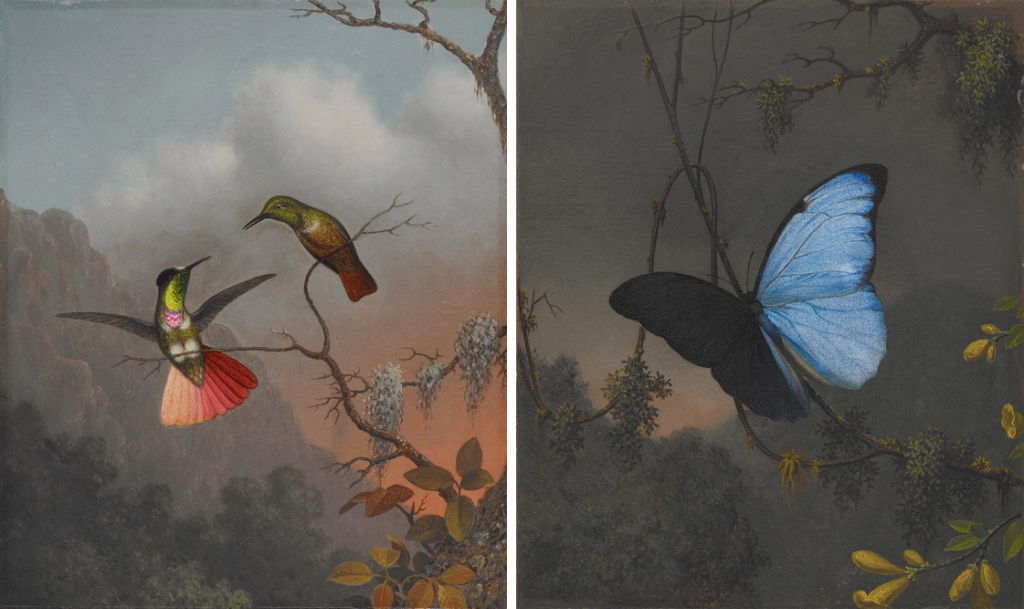Welcome to Conversations across Collections. This entry is the first in a collaborative series between the Archives of American Art and Crystal Bridges where we share the archival backstory on art objects from each of our collections. In this blog, Mindy Besaw, curator, American art and director of fellowships and research, discusses how Martin Johnson Heade blended natural science and art in his The Gems of Brazil. Once you’ve read this story, hop over to the Archives of American Art and learn more about Heade’s hummingbird notebook.
The 16 Gems of Brazil paintings of hummingbirds (and one butterfly) by Martin Johnson Heade are arresting, inspiring awe and wonder for our natural world. Heade’s ambition was to view hummingbirds in their natural habitat and produce paintings that would serve as the basis for a magnificent publication titled Gems of Brazil. In 1863, Heade journeyed by steamship from New York to Brazil where he stayed in Rio de Janeiro for nearly seven months.
Science and Art
From our current vantage point, it is hard to imagine how intertwined the arts and natural sciences were in the nineteenth century. Heade was a self-proclaimed artist-naturalist with a wide range of interests and talents, including painting, poetry, and natural sciences. Today, viewed in the context of an art museum, the science of The Gems of Brazil takes a back seat to the art. In order to understand how Heade infused the paintings with science and art, observation and romanticism, and realism and fiction, a closer look at the paintings with a healthy dose of naturalist insight is necessary.
Looking at the paintings through the eyes of avid birder and trained entomologist Dr. Robert Wiedenmann of the University of Arkansas highlighted many biological details in the paintings that I had not noticed. The colors Heade used, more than functioning as pleasing and interesting, perfectly captured the brilliant iridescence of the hummingbirds at the fleeting moment when the feathers catch the light in optimal conditions. Heade’s background landscapes are each unique, ranging from cloud forests to the dry almost desert-like habitat of the Caatinga. Other details show modifications and decisions Heade made when he translated scientific information into a painting.

For example, Heade intensified the color of the tail on the male Hooded Visorbearer, which actually appears more copper than red in life. Also, the landscape surrounding the Hooded Visorbearer (one of only four species in the Crystal Bridges collection endemic to Brazil) is mismatched, as the species lives in a dry habitat with cacti, as opposed to the lush landscape of Heade’s painting. I also learned there are more than 12 species of Blue Morpho butterflies. While Heade is masterful at capturing the details of the wings and light illuminating one iridescent wing in the otherwise dark forest, the butterfly represents an artistic composite of characteristics from several species.
Heade traveled to Brazil because he felt that the only way to represent hummingbirds properly was to observe them from life on their native soil, which differentiated Heade from other scientific illustrators like John James Audubon. In Rio de Janeiro, Heade could see several species in the surrounding forests, but he had access to countless more at the markets. For example, the Snowcap is a Central American bird found from Honduras to Panama, but Heade acquired a specimen while in Rio. Heade collected and studied bird specimens closely, even dissecting one to better understand hummingbirds’ diets, which include minute insects and spiders in addition to flower nectar. The art is ultimately amplified through Heade’s direct observation and inclusion of scientific detail.
Explore The Gems of Brazil in a New, Interactive Experience
NEW: Travel with Martin Johnson Heade to Brazil and create your own painting of hummingbirds, butterflies, and the Brazilian forest in our new interactive! Click here to begin.
The 16 paintings are the centerpiece of a new exhibition, Cross Pollination: Heade, Cole, Church, and Our Contemporary Moment, opening October 28 at the Cummer Museum of Art in Jacksonville, Florida, and then traveling to four additional venues. It will open at Crystal Bridges in November 2021.
There’s More to the Story
Want to learn more about Heade’s hummingbird adventures? Read the Archives of American Art blog about Heade’s hummingbird notebook.
This post was written by Mindy Besaw, curator, American art and director of fellowships and research, Crystal Bridges.
Special thanks to our collaborators:






